Foreign Insulators
by Marilyn Albers
Reprinted from "Crown Jewels of the Wire", June 1995, page 10
THE CAPANEMA PATTERN
This unusual looking porcelain insulator made its appearance in November of
1994 at the London, Ohio show. It has no marking of any kind. At that time, no
one seemed to know anything about it, but something made me think I’d seen it
before. So when I got home from the show, I attacked my file of European
insulator manufacturers and finally found a copy of the Letters Patent for this
style which had been issued to Guilherme Schuch de Capanema of Rio de Janeiro,
Brazil, on May 29th, 1874. Mr. Capanema traveled to England and left his
Petition for a Patent at the Office of the Commissioners of Patents on December
19, 1873. The Patent was sealed on May 29, 1874 and then signed by him on June
5, 1874.
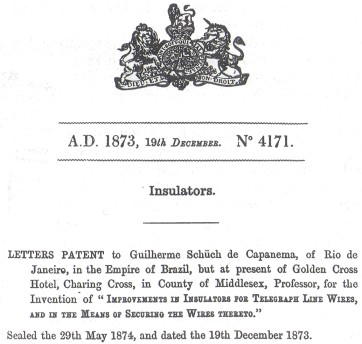
Further digging produced a drawing of the insulator in a March, 1910 catalog
of Siemens Brothers & Co., Ltd. of London, which identified it as the
CAPANEMA PATTERN, and declared it to be the standard Brazilian Pattern for use
over the entire Telegraph system in Brazil. The insulator was available in three
sizes:
CAPANEMA No. 1 (Fig. 1) - 6" x 3-7/8", with a
stalk-hole suitable for a 3/4" diameter metal stalk
CAPANEMA No. 2 (Fig. 2) - 5-1/4" x 3-1/2", with a stalk-hole suitable for a 5/8" diameter metal stalk
CAPANEMA No. 3 (Fig. 3) - 4-1/2" x 3", with a stalk-hole suitable for a 5/8" diameter metal stalk.
Any of the three sizes of stalk-holes could be made to accommodate stalks for
cementing in or screwing in with hemp.
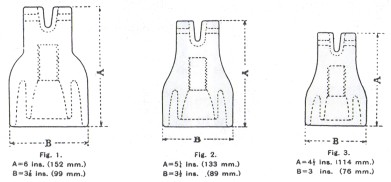
Quoting from the 1910 catalog, “The top of the porcelain is formed with a
circular recess in the center and a slot at each side. A small ball of solder is
cast on the wire by means of a special mold and the wire is held in the
porcelain as shown below. The solder bullet is prevented from rising by means of
a pin, which passes through two small holes in the porcelain. This pin, bent at
one end, is supplied with the insulators, which will take wires up to .212
inches (5.5 mm.) diameter.” You can see this arrangement in the drawings
below, followed by three photos which show the front, side and top views of
CAPANEMA No. 1, the actual specimen found at the London Show.
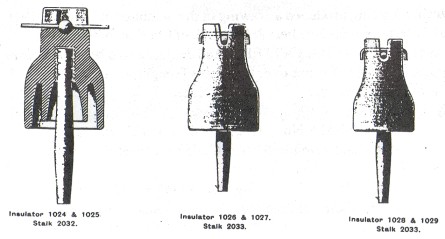
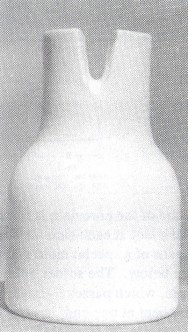 |
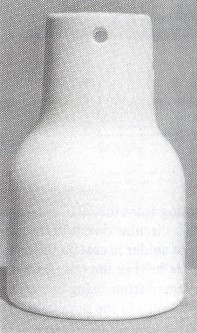 |
|
Capanema Pattern - front view and side view |
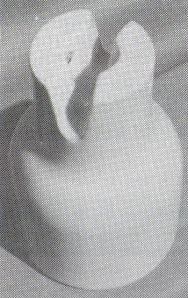
Capanema Pattern - top view
It’s quite a feeling of satisfaction to be able to attribute an insulator
like this to a particular manufacturer and know the approximate date of
manufacture, and to learn how it was intended to be used by the man who designed
it. All three sizes of the CAPANEMA insulator will be assigned new U-numbers,
though no decision has been made at this time. I am quite certain that all three
were produced and put into service in Brazil, but would appreciate hearing from
anyone who has found either the medium or small size of this insulator,
particularly if it has any marking. It may be that companies other than Siemens
Brothers also had license to produce this particular style.
THE EVER POPULAR GO-WITHS
ANOTHER GREAT SIGN - This enameled metal sign from Poland is especially
attractive in colors of black, white and yellow. The words translate to “DON’T
TOUCH! ELECTRICAL INSTALLATION”. Again, many thanks to Frantisek Danek of the
Czech Republic for finding this one while hunting for insulators in Poland. The
many foreign signs that decorate our garage walls would best be described as a
“color scream” and I love it!
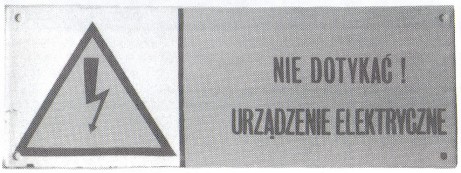
AN ITALIAN COOKIE JAR - While visiting his sister’s home in New Jersey a
while back, Bob Stahr noticed the words “I VETRI DE FIDENZA and MADE IN ITALY
plus some sort of logo (which resembles one of those ready made ribbon bows)
embossed on the inside of the lid of her glass cookie jar! He was very intrigued
so she told him where she had bought it, then he phoned me to ask if I’d ever
seen one like this and was I interested? Needless to say, there was a lot of
jumping up and down at the Houston end of the line, so he set about finding one
for my collection of go-withs. What a neat thing to do. A star in his crown!
Apparently the jars are available in several sizes and the chain of shops that
carry them is called LECHTERS, INC. Perhaps there is one in your area, if you
are interested. My preference was for a small jar and he found one in 1/2 liter
size, which is shown in the photo below sitting beside a CD 677.7 marked FIDENZA
/ 6118. Both of these Italian relatives are made of near clear glass and make a
great pair! FIDENZA is currently very actively engaged in the manufacture of
glass products for a worldwide market.
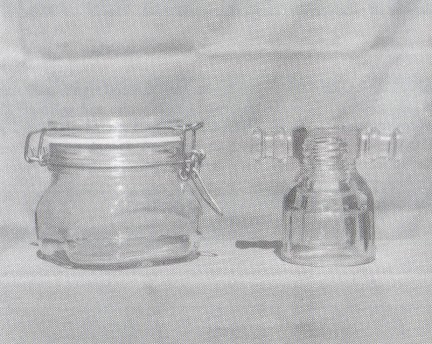
| 